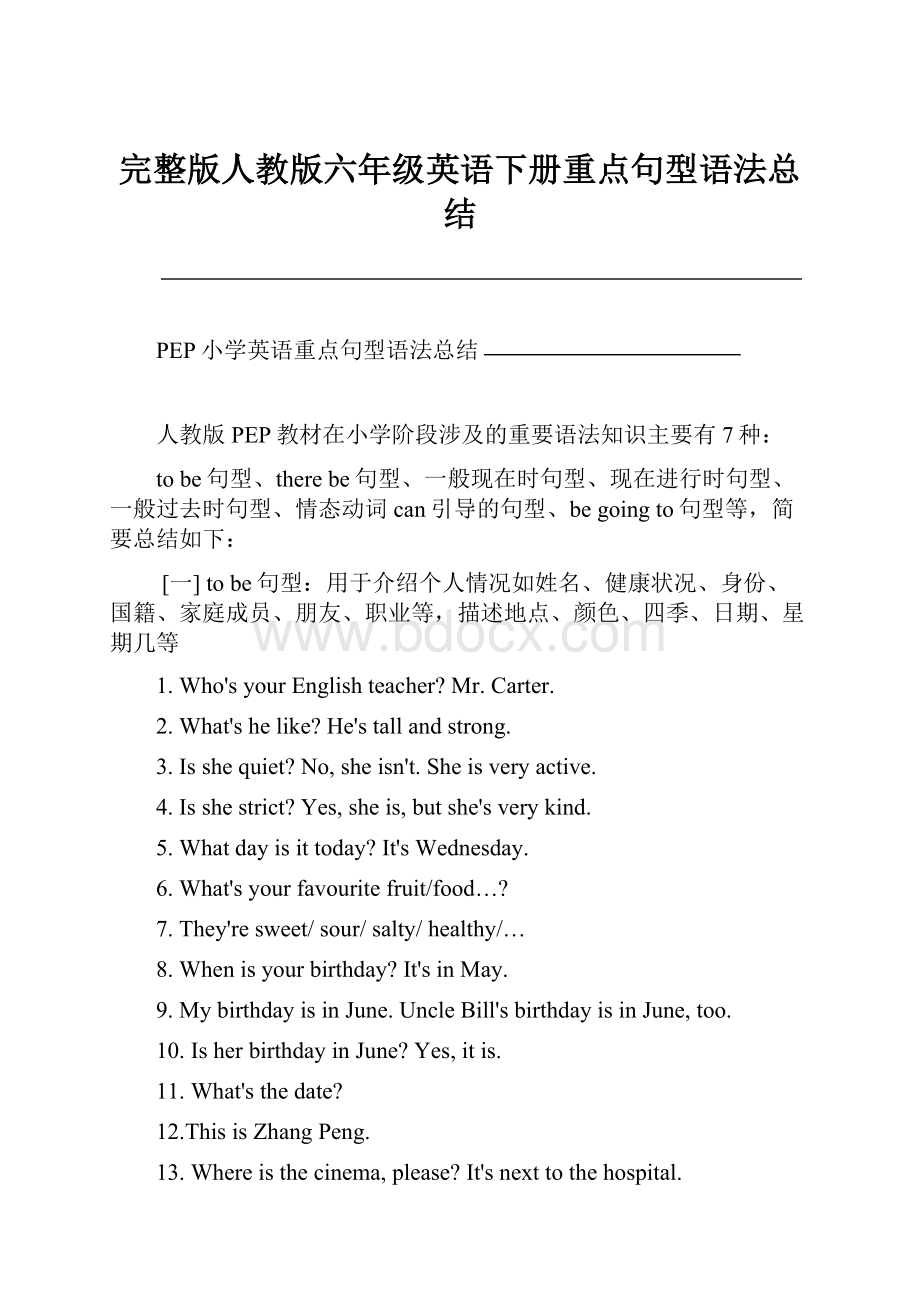完整版人教版六年级英语下册重点句型语法总结.docx
《完整版人教版六年级英语下册重点句型语法总结.docx》由会员分享,可在线阅读,更多相关《完整版人教版六年级英语下册重点句型语法总结.docx(21页珍藏版)》请在冰豆网上搜索。

完整版人教版六年级英语下册重点句型语法总结
PEP小学英语重点句型语法总结
人教版PEP教材在小学阶段涉及的重要语法知识主要有7种:
tobe句型、therebe句型、一般现在时句型、现在进行时句型、一般过去时句型、情态动词can引导的句型、begoingto句型等,简要总结如下:
[一]tobe句型:
用于介绍个人情况如姓名、健康状况、身份、国籍、家庭成员、朋友、职业等,描述地点、颜色、四季、日期、星期几等
1.Who'syourEnglishteacher?
Mr.Carter.
2.What'shelike?
He'stallandstrong.
3.Isshequiet?
No,sheisn't.Sheisveryactive.
4.Isshestrict?
Yes,sheis,butshe'sverykind.
5.Whatdayisittoday?
It'sWednesday.
6.What'syourfavouritefruit/food…?
7.They'resweet/sour/salty/healthy/…
8.Whenisyourbirthday?
It'sinMay.
9.MybirthdayisinJune.UncleBill'sbirthdayisinJune,too.
10.IsherbirthdayinJune?
Yes,itis.
11.What'sthedate?
12.ThisisZhangPeng.
13.Whereisthecinema,please?
It'snexttothehospital.
14.Howtallareyou?
I'm164cmtall.
15.Youareshorterthanme.
16.You're4cmtallerthanme.
17.Howheavyareyou?
I'm48kg.
18.I'mthinnerthanyou,andshorter.
19.What'sthematterwithyou?
Mythroatissore.
20.Howareyou,LiuYun/Sarah?
[二]therebe句型:
表示存在,即:
“某处有某物”或“某时有某事”。
句型基本结构为:
Thereis+可数名词单数或不可数名词+时间或地点。
Thereare+可数名词复数+地点。
如:
1.Therearetwobedrooms,akitchen,abathroomandalivingroom.
2.Thereisamirror,abedandabigcloset.
--1--
3.Isthereaforestinthepark?
Yes,thereis.
4.Isthereariver?
No,thereisn't.
5.Arethereanypandasinthemountains?
No,therearen't.
6.Arethereanyfishintherivers?
Yes,thereare.
[三]一般现在时句型:
表示习惯性的动作或行为,或现在存在着的状况。
句型基本结构为:
主语+行为动词+其他。
当主语是第三人称单数时,要在动词原形后面加s或es,其他人称作主语时则用动词原形,在问句及否定句中需要用助动词do或does。
这种句型通常有一些标志词,如:
usuallyoftensometimesneveralways等。
1.WhatdoyouhaveonThursdays?
WehaveEnglish,mathandscienceonThursdays.
2.WhatdoyoudoonSaturdays?
IwatchTVonSaturdays.
3.Idomyhomework.
4.WhatdoyouhaveforlunchonMondays?
Wehavetomatoes,tofuandfish.
5.Ilikefruit.ButIdon'tlikegrapes.
1.Whendoyoueatdinner?
Ieatdinnerat7:
00intheevening.
2.Whendoyougetup?
Iusuallygetupat12:
00noon.
3.Whatdoyoudoontheweekend?
UsuallyIwatchTVandgoshopping.
4.SometimesIvisitmygrandparents.Ioftenplayfootball.SometimesIgohiking.
5.Whichseasondoyoulikebest?
Ilikewinterbest.
6.Whydoyoulikesummer/winter?
1.Howdoyougotoschool,Sarah?
2.UsuallyIgotoschoolonfoot.SometimesIgobybike.
3.Ilikecollectingstamps.Helikescollectingstamps,too.
4.Doessheteachmath?
Yes,shedoes.
5.DoessheteachEnglish?
No,shedoesn't.Sheteachesmath.
6.Whatdoesyourmotherdo?
Whatdoesyourfatherdo?
7.Wheredoesshework?
Sheworksinacarcompany.
8.Howdoesshegotowork?
Shegoestoworkbybus.
9.Wheredoestheraincomefrom?
Itcomesfromtheclouds.
10.Wheredoesthecloudcomefrom?
Itcomesfromthevapour.
11.Wheredoesthevapourcomefrom?
Itcomesfromthewaterintheriver.
--2--
12.Thesunshinesandthewaterbecomesvapour.
13.Howdoyoudothat?
1.Mynosehurts.
2.Howdoyoufeel?
Ifeelsick.HowdoesAmyfeel?
3.Youlooksohappy.Youlooksadtoday.
[四]现在进行时句型:
表示说话时正在进行的动作或事件,或在短期内正在进行的动作或存在的情况。
标志词是:
now也常用在Look!
Listen!
等后面。
句型主要结构为:
be动词(am,is,are)+动词现在分词(v.ing)。
1.Whatareyoudoing?
I'mdoingthedishes.I'mreadingabook.
2.Grandpaiswritingaletter.Brotherisdoinghomework.Momiscookingdinnerinthekitchen.
3.Heiswritingane-mailinthestudy.
3.Whatisitdoing?
It'seatingbananas.
4.Whatisshedoing?
She'sjumping.
5.Whataretheydoing?
They'reswimming.They'reclimbingtrees.
6.Areyoueatinglunch?
No,wearen't.
7.Aretheyeatingthehoney?
Yes,theyare.
8.Isheplayingchess?
Yes,heis.
9.Isshecountinginsects?
No,sheisn't.
[五]一般过去时句型:
表示过去发生的而现在已经结束的事件、动作或情况。
句型基本结构为:
主语+动词过去式+其他。
标志词通常是:
yesterday,lastweek,lastyear等,在问句与否定句中要用助动词did。
1.Whatdidyoudolastweekend?
Iplayedfootball.
2.Didyouhelpthemcleantheirroom?
Yes,Idid.
3.Whatdidyoudoyesterday?
Iwentfishing.
4.Didyoureadbook?
Yes,Idid.
5.Didyoucleanyourroom?
No,Ididn't.
6.Wheredidyougoonyourholiday?
IwenttoXinjiang.
7.Whatdidyoudothere?
Isanganddancedwithmynewfriends.
8.Howdidyougothere?
Iwentbytrain.
此外,一般过去时也可用来表示客气的询问。
如:
--3--
Whatwouldyoulikeforlunch?
I'dlikesome…
can后面的动词要用原形。
如:
六[]情态动词can引导的句型:
表示有能力做某事,Icansweepthefloor.1.Whatcanyoudo?
Icancookthemeals.
2.Icanwatertheflowers.
No,Ican't.3.Canyoumakethebed?
Yes,Ican.
4.Canyouuseacomputer?
YoucangobytheNo.15bus.
HowcanIgettoZhongshanPark?
bebegoingto句型,主要以]将来时:
我们的教材中出现过两种表示将来时的句型,即:
will和[七原形。
标am/is/are+goingto+v.goingto句型为主,表示将要做某事或打算做某事。
句型主要结构:
next…begoingtonextweekendtomorrowthismorningthisweekend志词有:
Iamgoingtovisitmygrandparents.1.Whatareyougoingtodothisweekend?
Iamgoingtothecinema.
2.Whereareyougoing?
HeisgoingtoBeijingbyplane.3.HowishegoingtoBeijing?
Sheisgoingtogothereat9:
00am4.WhenisshegoingtoXiashan?
英语名词单数变复数的规则
1)单数名词加s:
students,apples,bags,trees,books,brothers.es:
glasses,boxes,brushes,matches.sh、ch以2)s、结尾的名词加x、加ies:
cities,babies,enemies.y结尾的名词,变y3)为以辅音字母加或fe结尾的名词,多数变f为v加4)以fes:
wives,knives.但有些词只加s:
roofs,proofs,chiefs.
5)以o结尾的名词,有些加es:
Negroes,heroes,tomatoes,potatoes.其它加s:
radios,zoos,pianos,
photos.
6)不规则名词:
foot→feet,goose→geese,tooth→teeth,child→children,man→men,
woman→women,sheep→sheep,deer→deer,mouse→mice.
7)某些外来词变复数:
datum→data,medium→media,bacterium→bacteria,curriculum→curricula,
criterion→criteria,phenomenon→phenomena.(um/on→a)analysis→analyses,
is→es)basis→bases,crisis→crises,diagnosis→diagnoses.(8)复合名词变复数:
以不可数名词结尾的复合名词无复数形式,如:
homework.
以man或woman为前缀的复合名词变复数,前后两个名词都变复数,如:
manservant→menservants,
womanstudent-womenstudents.
--4--
law,
ininup→grownlaw→brothers其它复合名词变复数:
grownups,brotherby→standsby.standpagebook
atwoyearhundred9)oldboy复合形容词做定语时,其中的名词保持单数:
asix,表示一个用单数,英语中名词可分为可数名词和不可数名词。
可数名词在应用时有单数和复数形式。
表示两个或两个以上用复数。
复数名词的构成分为规则变化和不规则变化。
规则变化:
1.,1)一般在名词词尾加s鸟,bird—birds①map—maps地图,桔子,orange—oranges
—bikes自行车;bike结尾的名词加es,2)以s,x,ch,shdish-dishes盘,碟子,餐具;班级,watch—watches手表,①box—boxes盒子,class—classesess或3)以O结尾的名词后面加zoos动物园收音机zoo—photos①photo—相片radio—radios土豆potato—potatoestomatoestomato—西红柿为i+es以辅音字母加y结尾的名词,变y4)
家庭;family—families①baby—babies婴儿
s结尾的名词直接加以元音字母加y—toys玩具;boy—boys男孩toy①
vesf变为或f结尾的名词,把fe或5)以fe小刀knives①knife—妻子wife—wives树叶。
leaf—leaves二:
名词复数的不规则变化child---childrenfoot---feettooth---teeth1)mouse---miceman---menwoman---women
。
构成的合成词,其复数形式也是-men和-women和注意:
与manwomanBowmanGermans故复数形式为;但如:
anEnglishman,twoEnglishmen.German不是合成词,theBowmans是姓,其复数是。
2)单复同形如:
--5--
Chinese,Japanesedeer,sheep,fish,threemu,fourjin,yuan,twoli,li,jin但除人民币元、角、分外,美元、英镑、法郎等都有复数形式。
如:
adollar,twodollars;ameter,twometers
)集体名词,以单数形式出现,但实为复数。
3,但可以说apeople,apolice,acattle如:
peoplepolicecattle等本身就是复数,不能说
thetheChinese,theBritish,theFrench,aperson,apoliceman,aheadofcattle,theEnglish,Japanese,theSwiss等名词,表示国民总称时,作复数用。
如:
TheChineseareindustriesandbrave.中国人民是勤劳勇敢的。
)trousers,clothes4)表示由两部分构成的东西,如:
glasses(眼镜);apairofglasses;twopairsoftrousers对,双);suit(套若表达具体数目,要借助数量词pair(fishes货物,goodswaters水域,5)另外还有一些名词,其复数形式有时可表示特别意思,如:
(各种)鱼现在分词构成do→doing,sing→singing,comfort→comforting①直接在动词的后面加上ing,如
dance→dancing,hike→hikinging,如②以不发音的e结尾的动词,把e去掉,再加
see→seeinge必须不发音,若发音,则不能去掉,如※注意※这里的,如③最后一个闭音节重读且后面只有一个辅音字母的动词,双写这个辅音字母再加ing
cut→cutting,swim→swimming
die→dying,lie→lyingingy再加,如④以ie结尾的动词,要把ie变成过去分词
(1)、一般动词,在词尾直接加“ed”。
(然而要注意的是,过去分词并不是过去式)
work---worked---worked,visit---visited---visited
(2)、以“e”结尾的动词,只在词尾加“d”。
live---lived---lived,
(3)、以“辅音字母+y”结尾的动词,将y变为i,再加“ed”。
study---studied---studied,cry---cried---cried,
(4)、重读闭音节结尾,末尾只有一个辅音字母,先双写该辅音字母,再加“ed”。
stop---stopped---stopped,drop---dropped—dropped
--6--
基数词变序数词
一、二、三,单独记;八加h,九去e,ve要用f替,
整十基数变序数,先把ty变成tie;
要是遇到两位数,十位基数个位序,th最后加上去。
解析口诀:
one→first,two→second,three→third这三个词变化特殊,要单独记;eight→eighth,nine→ninth,八去t,九去e后再加-th;five→fifth,twelve→twelfth,五、十二把ve换成f再加-th;twenty→twentieth,thirty→thirtieth...整十先把词尾y改为ie再加-th。
两位数时则十位数用基数词,个位数用序数词,如:
twenty-first。
--7--